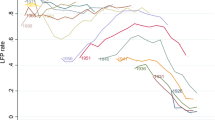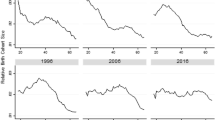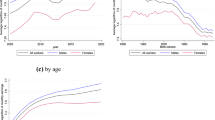Abstract
Recent changes in the labour market in France, more particularly changes in labour supply and in unemployment, are examined. Particular attention is paid to the arrival of the baby boom on the labour market. The effect of demographic changes is, however, shown to have been less than that of behavioural changes.
Relative earnings of successive cohorts are also examined, and the earnings-gap between baby boomers and preceding cohorts is discussed and compared with that observed in the USA. The evidence suggests that with earnings too, non-demographic factors have been important: the inequities observed in the earnings of a number of cohorts cannot be fully explained by relative cohort size.
Résumé
L'auteur étudie l'évolution récente du marché du travail en France, et plus particulièrement les changements intervenus dans l'offre de travail et le chômage. Elle met spécialement l'accent sur l'arrivée des générations du baby-boom sur le marché du travail et montre que, malgré tout, l'effet de l'évolution démographique a été moins important que celui des changements de comportement.
Analysant également les revenus relatifs des générations successives, l'auteur examine l'écart de revenu entre les générations du baby-boom et cells qui les ont précédées, et fait une comparaison avec la situation aux Etats-Unis. Les résultats indiquent que, pour les revenus aussi, des facteurs non démographiques ont eu un effet important : les différences d'effectifs de plusieurs générations ne peuvent expliquer entièrement les inégalités de revenu qu'on y observe.
Similar content being viewed by others
References
Ahlburg, D.A., 1982, The new Kuznets Cycle: A test of the Easterlin-Wachter-Wachter hypothesis, in: J.L. Simon and P.H. Lindert, eds., Research in Population Economics, Vol. 4 (JAI Press, Greenwich, CT) 93–115.
Alsalam, N., 1985, The effect of cohort size on earnings: An examination of substitution relationships, Working paper no. 21 (Center for Economic Research, University of Rochester, Rochester, NY).
Anderson, J.M., 1982, An economic-demographic model of the US labor market, in: J.L. Simon and P.H. Lindert, eds., Research in Population Economics, Vol. 4 (JAI Press, Greenwich, CT) 117–153.
Ben-Porath, Y., 1985, Market, government and Israel's muted baby boom, Working paper no. 1569 (National Bureau of Economic Research, New York).
Berger, Mark, 1984, Cohort size and the earnings growth of young workers, Industrial and Labor Relations Review 37, 582–591.
Berger, Mark, 1985, The effect of cohort size on earnings growth: A reexamination of the evidence, Journal of Political Economy 93, no. 3, 561–573.
Bloom, D. and R. Freeman, 1986, The youth problem: Age or generational crowding? Discussion paper no.86-3. (Center for Population Studies, Harvard University, Cambridge, MA; revised version published in European Journal of Population 3, no. 2).
Briant, P., 1986, Démographie et marché du travail, Mémoire de DEA (Institut d'Etudes Politiques, Paris).
Colletaz, G., 1988, Les différences de salaires entre hommes et femmes, in: M. Riboud and G. Colletaz, eds., Offre de travail et salaires féminins (Presses Universitaires de France, Paris).
Connelly, R., 1986, A framework for analyzing the impact of cohort size on education and labor earnings, The Journal of Human Resources 21, no. 4, 543–562.
Dooley, M.D., 1985, Changes in the relationship among earnings, education and age for Canadian men: 1971–1981, Working paper no. 87-17 (Department of Economics, McMaster University, Hamilton, Ont.).
Easterlin, R., 1968, Population, labor force and long swings in economic growth: The American experience (Columbia University Press, New York).
Ermisch, J., 1983, The political economy of demographic change (Heineman, London).
Falaris, E.M. and H.E. Peters, 1985, The effect of the demographic cycle on schooling and entry wages, Working paper no. 85-4 (Department of Economics, Ohio State University, Columbus, OH).
Freeman, R., 1976, The overeducated American (Academic Press, Orlando, FL).
Freeman, 1979a, The effect of demographic factors on age-earnings profiles, Journal of Human Resources 14, 289–318.
Freeman, R., 1979b, The effect of generational crowding on the labor market for young male workers, Proceedings of the American Statistical Association, 46–49.
Freeman, R., 1981a, Career patterns of college graduates in a declining labor market, Working paper no. 750, (National Bureau of Economic Research, New York).
Freeman, R., 1981b, The changing economic value of higher education in developed economies: A report to the OECD, Working paper, no. 820 (National Bureau of Economic Research, New York).
Jarousse, J.P. and A. Mingat, 1986, Un réexamen du modèle de gains de Mincer (CREDOC-IREDU, University of Dijon, Dijon).
Leveson, I., 1980, Generational crowding: Economic, social and demographic effects of changes in relative cohort size (Hudson Institute, New York).
Mincer, J. and Y. Higuchi, 1987, Wage structures and labor turnover in the US and in Japan, Working paper no. 2306 (National Bureau of Economic Research, New York).
OECD, 1979, Demographic trends (OECD, Paris).
OECD, 1980, Youth unemployment: The causes and consequences (OECD, Paris).
OECD, 1986, Historical statistics, 1960–1984 (OECD, Paris).
Riboud, M., 1977, An analysis of earnings distribution in France, Ph.D. dissertation (University of Chicago, Chicago, IL).
Riboud, M., 1978, Accumulation du capital humain (Economica, Paris).
Riboud, M., 1985, An analysis of women's labor force participation in France: Cross-section estimates and time-series evidence, Journal of Labor Economics 3, no. 1, S177–200.
Russell, L., 1982, The baby boom generation and the economy, Brookings Studies in Social Economics (The Brookings Institution, Washington, DC).
Tan, H.S. and M.P. Ward, 1985, Forecasting the wages of young men: The effects of cohort size, Report R-3115-Army (Rand Corp., Santa Monica, CA).
Wachter, M., 1972, A labor supply model for secondary workers, Review of Economics and Statistics 54, 141–151.
Wachter, M., 1976, The changing cyclical responsiveness of wage inflation over the postwar period, Brookings Papers on Economic Activity (The Brookings Institution, Washington, DC) 115–159.
Wachter, M., and C. Kim, 1982, Time series changes in youth joblessness, in: R. Freeman and D. Wise, eds., The youth labor market problem: Its nature, causes and consequences (National Bureau of Economic Research, distributed by University of Chicago Press, Chicago, IL) 155–185.
Welch, F., 1979, Effects of cohort size on earnings: the baby boom babies financial bust, Journal of Political Economy 87, 565–597.
Author information
Authors and Affiliations
Rights and permissions
About this article
Cite this article
Riboud, M. Labour-market response to changes in cohort size: The case of France. Eur J Population 3, 359–382 (1988). https://doi.org/10.1007/BF01796905
Issue Date:
DOI: https://doi.org/10.1007/BF01796905




